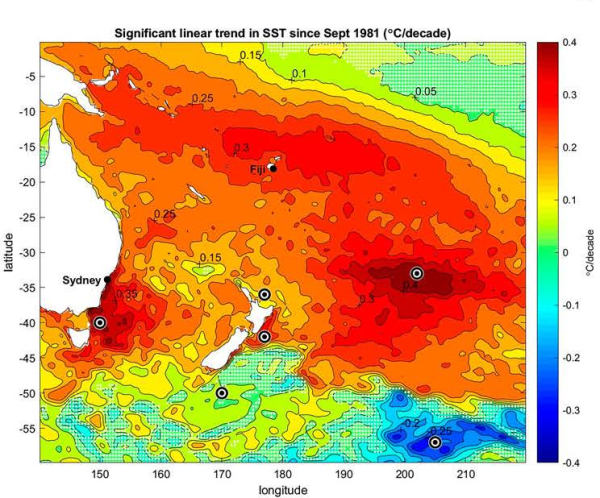The water in the New Zealand region is significantly warmer than it was 30 years ago, and all indications are the warming trend will continue, says a NIWA scientist.
Oceanographer Dr Phil Sutton is the lead author on a scientific paper published today, that analyses ocean temperature changes around New Zealand for the last 36 years.
He says the strongest warming near NZ has occurred off the Wairarapa Coast, and the weakest along the northeast coast between North and East Capes. And the increased warmth isn’t only at the surface – around New Zealand the increased warmth penetrates in places to 200m deep while in the Tasman Sea it reaches down to at least 850m.
“Since 1981 we are talking of warming of about 0.1 to 0.3ᵒC per decade. That may not sound like a huge amount but slightly stronger warming of about 0.4ᵒC per decade off the east coast of Tasmania has resulted in significant changes to ecosystems which has led to concerns of similar impacts in New Zealand,” Dr Sutton says.
The results have been published in the New Zealand Journal of Marine and Freshwater Research. Dr Sutton and co-author Dr Melissa Bowen, of Auckland University, analysed three data sets and applied mathematical equations to determine if the changes were statistically significant.
The longest data set is daily satellite measurements of sea surface temperatures which began in 1981. The second set is derived from ship-based measurements of the ocean down to 850m depth along two transects, or lines, from Sydney to Wellington which began in 1991, and Auckland to Suva which started in 1987.
The final data set was information from floats used in the Argo programme, an international network of floats in the world’s oceans that measure temperature, salinity and currents in the top 2000m of the oceans.
Dr Sutton says there were two areas in the South Pacific region where it was well known that strong warming had occurred: east of Tasmania and in the central Pacific, east of North Cape. The Australian warming is attributed to current flows pushing warmer water further south, while the central Pacific was affected by the South Pacific gyre – a system of circulating ocean currents - speeding up.
However, Dr Sutton says there is variability from decade to decade that needed to be taken into account. “The 1990s was a cooler period around New Zealand but it warmed up later in the decade with 1998 the second equal hottest year on record. But since 2000 there hasn’t really been any warming off the Wairarapa.
“There is definitely a warming trend but there is a lot of decadal variability behind it.”
Cooler years could largely be attributed to El Niño conditions but the warming ocean trend was affecting the water around New Zealand’s entire coast to at least 100m deep.
Dr Sutton says the most obvious cause is climate change.
“There is nothing here that is out of step with what has been projected to happen. We would expect to see this continue – perhaps the warming in the northeast will continue to be weak but you would suspect the Wairarapa Coast to be vulnerable to further change.
“The 30-year time series is long enough to see long-term changes and there is no reason to think this will turn around.”
Dr Sutton is hopeful the information will be useful to the other marine scientists, commercial fishing industry and aquaculture.


